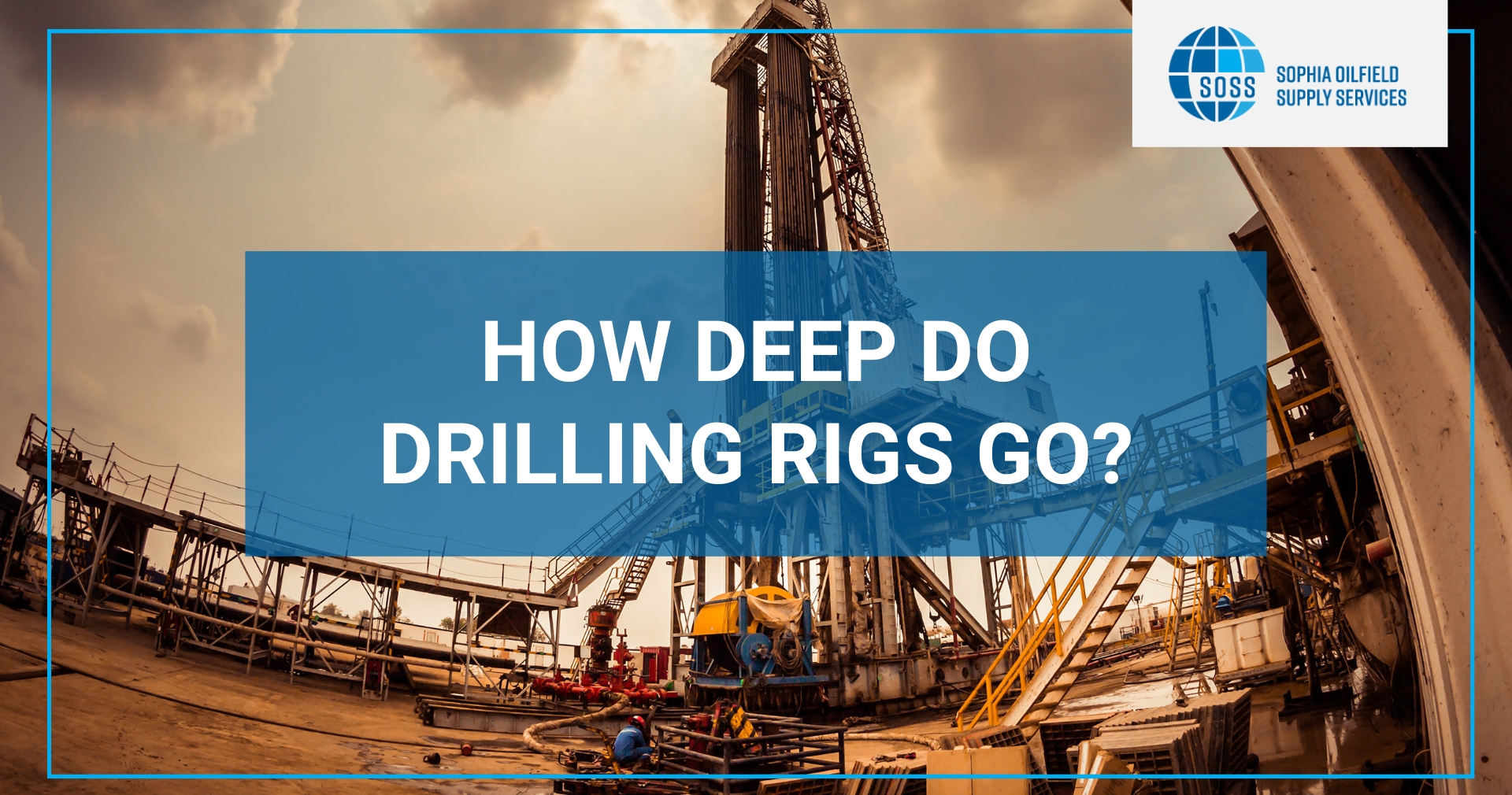Oil and natural gas exploration and production is a lengthy and intricate process that requires meticulous planning, a skilled workforce, and specialized drilling apparatus. Drilling rigs are the backbone of any drilling operation in the oil, gas, and mining industries. But how deep do drilling rigs go to extract the earth’s resources?
Read on to discover exactly how deep drilling rigs can go and the complex technologies that enable these machines to drill onshore and offshore wellbores.
How Deep Do Drilling Rigs Go?
Today’s oil rigs, particularly offshore oil rigs like the Deepwater Titan drillship, can achieve astonishing drilling depths ranging from 30,000 to 40,000 feet under the ocean floor while operating in ultra-deep waters from 400 to 12,000 feet deep.
How Do Drilling Rigs Go So Deep?
Whether it is offshore oil drilling or onshore drilling, oil rigs are equipped with multiple complex systems that work in conjunction to drill into the earth. Sophisticated modern drilling technologies enable rigs to access natural resources like crude oil and gas many kilometers deep under the land and ocean surface.
Types of Drilling Rigs And Their Depths
Oil wells exist in varying depths, with some as deep as 40,000 feet. How deep drilling rigs go mainly depends on the type of drilling rig, with each offshore drilling rig featuring varying capabilities, as discussed below. To learn more about the different types of drilling rigs, visit this detailed guide.
Barge Rigs
Barge rigs are the simplest of all rigs, able to go as much as 20 feet deep only. However, they can drill at significant depths under the ocean floor, ranging from 15,000 to 25,000 feet.
Drilling barges are typically used in the calm waters of lakes, swamps, etc., where there is minimal interference from lateral forces that could affect their stability. They are floated to different sites, and the hull or columns provide the platform for drilling by resting on the seafloor.
Jackups
Jack up rigs are mobile platforms used for shallow water operations. These offshore rigs operate in waters up to 400 feet deep and can drill up to 30,000 to 35,000 feet beneath the seabed.
The most commonly used type of rigs, they feature long, movable legs that are lowered to the ocean floor while the platform is raised above the water surface and the waves. The legs provide stability by guarding the platform from winds as well.
Jack up rigs can be towed to various drilling sites, making them a preferred choice for exploratory drilling without the significant cost of a permanent rig.
Semisubmersibles
Semisubmersibles are deepwater rigs that operate in deep waters ranging from 600 to 10,000 feet and drill 35,000-4000 feet below the seabed. These capabilities make them a viable alternative to jack-up rigs for deep water and developmental drilling activity.
These floating rigs float on large pontoons partially submerged beneath the water surface. They are attached to the seafloor using mooring lines that anchor the rig to the bottom or use a dynamic positioning system that keeps it in place using thrusters.
Drillships
Drillships are mobile marine vessels used for drilling at extreme depths of 12,000 feet or even more while reaching drilling depths as much as 40,000 feet under the sea floor.
Equipped with state-of-the-art drilling apparatus like blowout preventers, these deepwater drilling rigs are well suited for exploratory and developmental drilling. They can explore deeper seas in remote locations, which conventional rigs might not be able to access.
These self-propelled vessels move from one site to another independently and uphold their stable, vertical position at the oil well location without anchor or mooring lines using a dynamic positioning system.
Submersibles
Similar to jack up rigs and an alternative to barges, submersible rigs are used in shallow waters that are 50-170 feet deep. The lower hull is flooded until it sinks or rests on the seabed, while the upper hull remains elevated above the water.
Once drilling is completed and it is time to move the offshore rig to a new site, the lower hull is floated black up by pumping the water out of it.
Platform Rigs
Offshore platform rigs are mounted on fixed structures known as platforms that are anchored to the ocean floor. Platform rigs are typically used at medium depths of up to 1500-3000 feet and drill up to 30,000 feet deep. They could either be fixed or a compliant tower.
Fixed platforms are immobile structures that can drill at depths as high as 1500 feet and are permanently fixed to the sea bottom on steel or concrete legs. They hold the drilling rig equipment and personnel and are suited for long-term developmental drilling at a particular drilling site.
Compliant towers are tall structures suited for drilling in deep waters and can be used to drill up to 3000 feet deep. They are also fixed to the seafloor using piles and are designed to sustain harsh offshore conditions, but also provide flexibility as they move or sway with the wind and waves, similar to a floating structure.
What Does a Drilling Rig Do?
Petroleum deposits are located in reservoirs deep under the land or the sea bed, necessitating oil rigs to penetrate extremely high depths to reach and take out these precious resources.
Simply put, drilling rigs drill a hole in the earth to extract oil. These giant megastructures house the drilling personnel and feature all the vital systems and their components that enable drilling deep wells in the earth’s surface. These include but are not limited to the derrick or mast, drill string, rotary bit, and mud pumps.
The derrick is a long tower located at the top of the rig that supports all the drilling apparatus, such as the drill string, which refers to multiple drill pipe lowered in and out of the borehole.
The Drilling Process
So, how do drilling rigs drill at such high depths? Let us take a quick look at how the oil drilling process works.
The rotary drilling rig is the most common type of rig used for this purpose, and it can drill several miles under the surface. Each rig features large diesel engines or an electric motor that generates power for the drilling equipment and machinery, including the hoisting system, rotary system, and circulation system.
After drilling a well, maintenance is essential to keep it operational over time. Understanding what workover rigs are can be crucial here. These rigs perform the vital task of repairing and maintaining wells, helping to prevent costly downtime and ensuring the well continues producing efficiently.
The hoisting system comprises several key components that allow the drill string to lift and lower during drilling. These include but are not limited to drawworks, crown block, and hook.
The higher the drilling depth, the longer the drill string becomes, which means more weight for the hoisting system or hook to handle.
The hook load capacity determines how much weight it can safely withstand while raising or lowering the drill string. A higher hook load capacity correlates to deeper drilling and vice versa. Therefore, it is an essential factor in determining how deep a drilling rig can go.
Part of the rotary system, the drill bit is at the core of the process, aided by the drill collar, which provides weight. It is attached to the drill string and continuously rotates to penetrate the surface and create a hole in the well. The drill string derives its power from a top drive or a rotary table and exerts the necessary downward force on the bit to twist and drill a hole.
The circulation system plays a crucial role in the process by circulating drilling mud in the drill string. It helps bring rock cuttings generated from drilling up the surface while maintaining wellbore pressure and cooling the bit. The drilling fluid is pivotal to ensuring wellbore stability and preventing it from collapsing as the bore hole gets deeper by offsetting formation pressures in the well from surrounding rocks.
.
The deeper the hole, the more risky and challenging drilling becomes. Drilling at high depths presents numerous hazards, such as extreme pressures and temperatures, and chances of kick and blowouts.
That’s where a blowout preventer comes in to enable deepwater drilling safely. This critical equipment is a standard safety measure in most modern rigs. It prevents the uncontrolled release of drilling fluids from the wellbore by sealing the well, mitigating the chances of blowouts and explosions, which could be potentially fatal for the rig crew.
About Sophia Oilfield Supply Services
Sophia Oilfield Supply Services prides itself on being a leading reputed provider of drilling products and equipment for more than 30 years. As drilling rigs are a massive investment and at the core of any drilling operation, it is vital to make the right decision. Our new and used drilling rigs for sale are engineered to operate in the roughest environmental conditions while maintaining their integrity and efficiency for decades.
Ready to take your drilling projects to greater heights? Contact us today to receive a customized estimate for your specific drilling rig. Our team of experts will advise you about the oil rig that fits your drilling demands and is guaranteed to provide peak performance and efficiency on the oilfield.

